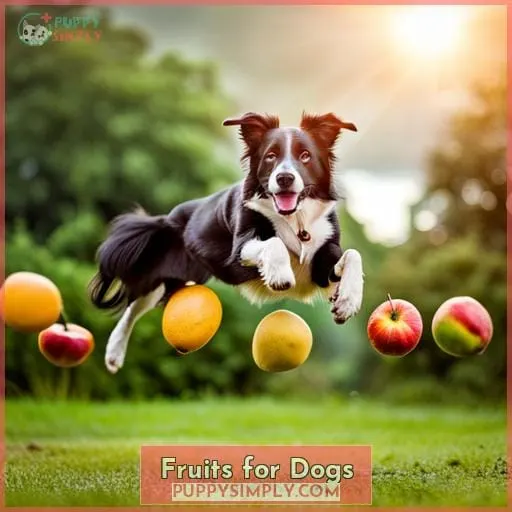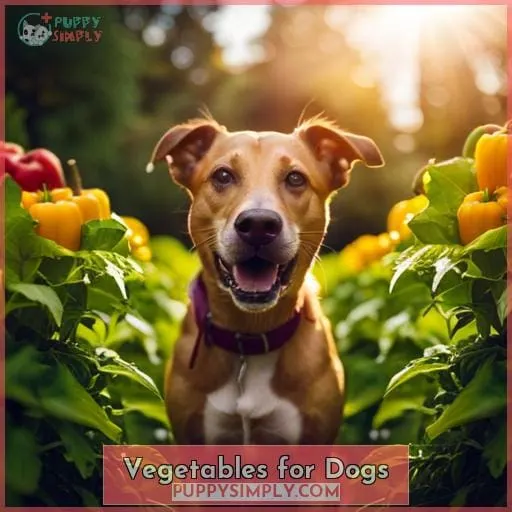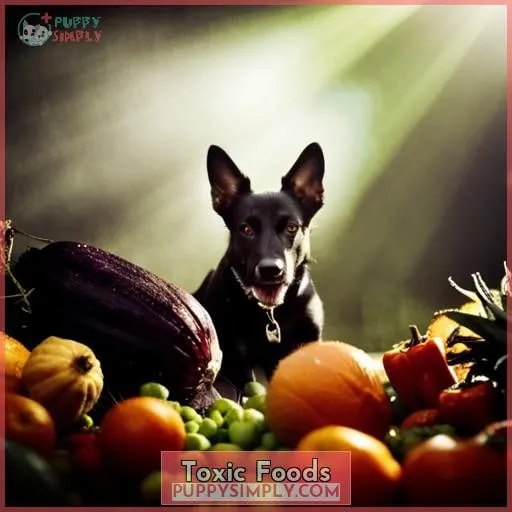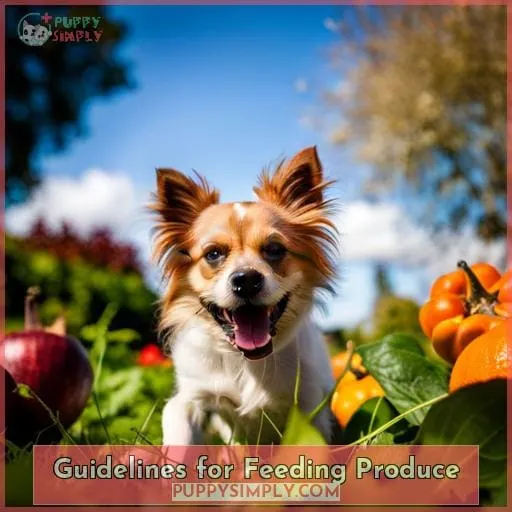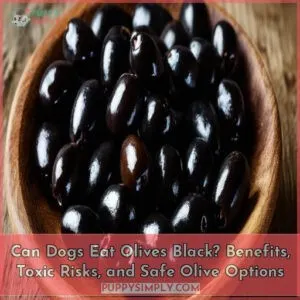This site is supported by our readers. We may earn a commission, at no cost to you, if you purchase through links.
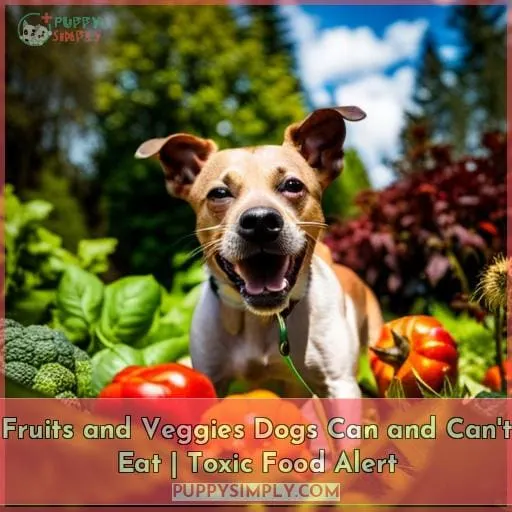 Like a culinary expedition, exploring the realm of edible fruits and vegetables for your canine companion is a journey fraught with both delectable discoveries and potential pitfalls.
Like a culinary expedition, exploring the realm of edible fruits and vegetables for your canine companion is a journey fraught with both delectable discoveries and potential pitfalls.
While nature’s bounty holds a trove of wholesome treats, certain offerings can unleash a symphony of digestive discord.
Embark on this odyssey armed with knowledge, discerning the safe havens from the treacherous shoals that await your furry friend’s palate.
Table Of Contents
- Key Takeaways
- Fruits for Dogs
- Vegetables for Dogs
- Toxic Foods
- Guidelines for Feeding Produce
- Incorporating Produce in Dog Food
- Frequently Asked Questions (FAQs)
- Should I wash fruits and vegetables before feeding them to my dog?
- How much fruit should I give my dog per day?
- What are some dog-friendly vegetable and fruit recipes I can make at home?
- If my dog has allergies or intolerances, what produce should I avoid?
- Are there any benefits to giving my senior dog fruits and vegetables?
- Conclusion
Key Takeaways
- Opt for dog-safe fruits like apples, bananas, and berries which offer vitamins, fiber, and other nutrients.
- Veggies like carrots, green beans, and lettuce make good options too. Introduce new items slowly.
- Onions and grapes top the list of dangerous foods. Even small amounts of onions can harm a dog’s red blood cells.
- While produce can supplement nutrition, a balanced commercial dog food remains essential.
Fruits for Dogs
When choosing fruits for your dog:
- Opt for apples, bananas, and berries.
- These fruits offer vitamins and fiber while being low in fat and calories.
Grapes and their dried products like raisins should always be avoided as they’re toxic to dogs.
Apples
Why are apples a great fruit treat for dogs?
You’re providing vitamins A and C when you give your pup a few apple slices.
As senior dog snacks, apple treats offer low protein, low-fat nutrition.
While reviewing fruit safety, know apple seeds contain cyanide, so core apples before feeding dogs.
For canine nutrition, apples are an ideal fruit, unlike grapes that are toxic for dogs.
With moderation, apple dog toys and treats nurture health.
Bananas
For dogs, bananas can be a healthy, low-calorie treat.
They’re high in potassium, vitamins, biotin, fiber, and copper, yet low in cholesterol and sodium.
Select bananas that are ripe but not overripe to maximize nutrients; underripe bananas can cause constipation.
Banana treats never overripen, providing long-lasting yummy delights.
Try homemade frozen banana pops or banana biscuits for tail-wagging goodness.
Bananas give nutritional benefits dogs crave.
Berries
Blueberries and cranberries are healthy treats for pups, packed with antioxidants and other beneficial nutrients.
Berries like strawberries, blackberries, and raspberries can also be given in moderation.
Take care to avoid grapes, raisins, and currants, as they’re toxic for dogs and can lead to kidney failure.
When serving berries, introduce new ones slowly and in small amounts to check for allergies.
Opt for fresh or frozen over dried.
Vegetables for Dogs
You can feed your dog carrots, green beans, and lettuce.
These vegetables provide vitamins, minerals, fiber, and limited calories.
Be cautious of sudden dietary changes and introduce new vegetables gradually.
Carrots
Try offering your dog some carrot sticks as a healthy, low-calorie snack.
Carrots are an excellent vegetable choice for dogs, packed with fiber, vitamins, and minerals.
You can even make homemade carrot treats for your furry friend.
However, it’s important to consider dietary considerations when feeding carrots to your dog to ensure their safety and well-being.
Green Beans
Why aren’t you giving your dog some green beans as a healthy, low-calorie treat?
They’re packed with vitamins, minerals, and fiber.
As a nutrient-rich produce, these tasty tidbits make excellent homemade or store-bought snacks.
Quick to prepare, green beans provide protein, vitamins A, C, K, folate, thiamine, and manganese essential for your canine companion’s health.
Unlike grapes, raisins, or onions, beans are a dog-friendly veggie safe to incorporate into a balanced diet.
Lettuce
You must consider that iceberg lettuce makes a low-calorie snack for your dog, though the nutrition it provides is limited.
Leafy lettuce varieties like romaine are more nutritious, packing vitamins A, K, and C.
Portion lettuce snacks carefully, as excess can cause loose stools.
Shredded lettuce can add crunch and hydration to your dog’s diet, but consult your vet before significantly adjusting their meals.
Toxic Foods
You must never feed grapes or raisins to your dog.
These fruits contain an unknown toxin that can cause acute kidney injury.
Onions are also highly toxic for canines and can damage red blood cells and cause gastrointestinal issues.
Grapes
The grapes you feed your dog can lead to acute kidney failure.
Their toxicity poses serious canine health risks.
Instead, offer safe, pet-friendly produce like blueberries or banana slices.
Consult dietary guidelines on fruits for dogs. Some human foods harm them, so knowledge protects our best friends.
Onions
Onions are extremely toxic to dogs.
Their compounds can damage red blood cells, causing anemia or even death.
Never feed dogs onions in any form, including powders, raw, cooked, or table scraps.
Even small amounts can be dangerous over time.
If unsure about a food’s safety, check with your veterinarian for guidance.
Offer dog-safe veggies like carrots or green beans instead.
Watch for symptoms like lethargy or brown urine.
Seek emergency care if poisoning is suspected.
Guidelines for Feeding Produce
When introducing produce into your dog’s diet, do so gradually and in moderation to avoid digestive upset.
Introducing produce like fruits and vegetables can provide dogs with appealing, nutrient-rich options like vitamins, minerals, and fiber.
However, dietary considerations are crucial when balancing canine nutrition.
Some safe treats include oranges for vitamin C or carrots for antioxidants.
Yet potentially harmful foods require caution – avocados, onions, mushrooms, and tomatoes can cause toxicity.
Gradually incorporate small amounts of produce to accustom digestion while monitoring stool quality and energy levels.
Overall, a nutritionally balanced commercial dog food remains vital, with produce incorporated moderately as supplemental nutrition.
Thoughtfully integrating fruits and veggies allows dogs to reap certain benefits of plant foods while avoiding pitfalls.
Monitoring reactions helps ensure optimum canine health is maintained.
Incorporating Produce in Dog Food
Many commercial dog foods already contain some fruits and vegetables which provide nutritional benefits.
When incorporating additional produce into a dog’s diet, do so gradually and in moderation to avoid digestive upset.
Consult your veterinarian for advice on safe options and quantities.
Some fruits and veggies like carrots, green beans, and apples can make healthy low-calorie treats.
Their fiber, vitamins, and antioxidants support weight loss, skin, coat, and overall health.
However, dietary guidelines still recommend meat as the primary component of a dog’s meals.
Homemade recipes with produce should be balanced and approved by a vet to ensure adequate nutrition.
With guidance, fruits, and vegetables can provide dogs safe variety and nutrients beyond commercial dog food alone.
Frequently Asked Questions (FAQs)
Should I wash fruits and vegetables before feeding them to my dog?
Yes, you should wash fruits and vegetables before feeding them to dogs.
This helps remove pesticides, dirt, and bacteria that could be harmful if ingested.
Thoroughly rinse produce under cool, running water.
Scrub firm produce with a clean produce brush.
Introduce new fruits and veggies gradually and in small amounts to avoid gastrointestinal upset.
Consult your veterinarian with any questions.
How much fruit should I give my dog per day?
You should limit fruit to 10% or less of your dog’s daily calories.
While small amounts of certain fruits can provide vitamins and fiber, excess sugar and difficulty digesting fruit makes more than the 10% limit generally unhealthy.
Introduce new fruits slowly and monitor your dog’s health.
What are some dog-friendly vegetable and fruit recipes I can make at home?
Carrot and apple bites:
- Grate carrots and apples.
- Form into small bites.
- Dehydrate.
Banana and peanut butter popsicles:
- Blend banana, peanut butter, and yogurt.
- Freeze in popsicle molds.
Pumpkin custard:
- Blend pumpkin, egg, and yogurt.
- Bake into custard cups.
Introduce new foods gradually.
If my dog has allergies or intolerances, what produce should I avoid?
If your dog has food allergies or intolerances, consult a veterinarian before introducing new foods.
Carefully monitor for adverse reactions when trying small amounts of new fruits or vegetables.
An elimination diet may help identify problem ingredients.
Focus on providing a nutritious, balanced diet within your dog’s dietary restrictions.
Are there any benefits to giving my senior dog fruits and vegetables?
Yes, senior dogs can benefit from fruits and vegetables.
They provide vitamins, minerals, fiber, and antioxidants.
Introduce new items slowly and consult your vet.
Choose dog-safe options without added salt or sugar.
Target weight management or digestive health.
Conclusion
Ultimately, through prudence and moderation, fruits and vegetables can augment your dog’s diet, furnishing nutrients and enhancing flavor.
Yet vigilance remains vital, as certain produce conceals toxicity.
By following feeding guidelines, incorporating modest amounts within balanced meals, and avoiding dangerous choices like grapes or onions, you can navigate this bounty, discovering healthy additions.
Discernment permits safely sharing nature’s gifts.

